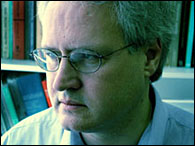Healing wounds faster
A McGill researcher has discovered that a naturally occurring protein may one day yield treatments for skin trauma, including burns, wounds and chronic ulcers.
 Professor Andrew Bateman
Professor Andrew BatemanPHOTO: Claudio Calligaris |
|
In an article in next month's issue of Nature Medicine, experimental medicine professor Andrew Bateman and his collaborators present lab results from their ongoing research on progranulin, a protein found in the lining of organs in the body.
"We've been studying progranulin for a long time; this is the first time it has been implicated in wounds," says Bateman, a researcher in the Royal Victoria Hospital's Endocrine Research Laboratory.
"We have shown that it has a role in the wound response, which is the body's normal process of repair. So we suspect that it may be possible to use it, either on its own or in combination with other agents, to speed up the body's natural healing."
Previously, the research team was looking at whether progranulin can be a possible tumour treatment. While that work is ongoing, their breakthrough came when they applied progranulin directly to wounds in the lab. They found that progranulin was promoting the growth of fibroblasts (cells which form the structure of the skin and produce collagen); endothilial cells (which form blood vessels); and neutrophils and macrophages (white blood cells, which create an immune response to guard against infection).
"When a wound occurs, one of the first things that has to happen is that the fibroblasts around the wound have to multiply through cell division and move into the wound to create a temporary tissue, which is formed underneath a scab. You also need blood supplies into the damaged tissue; otherwise, it won't have enough oxygen and nutrients to repair itself. The wound won't heal if either of these processes doesn't work properly."
Progranulin cells act as a kind of emergency response team, arriving on the scene of a wound almost instantly.
"In normal skin, we found no presense of progranulin in either fibroblasts or in blood vessel cells. But as soon as the skin is damaged, almost immediately progranulin is present in both. That is the first time we've seen this protein expressed in those types of cells. The next natural step was to take progranulin and apply it to wounds in mice. When we did that, there was an increase in white blood cells, fibroblasts and blood vessels, so we were able to accelerate the formation of temporary tissue in the early stages of wound repair."
Next, they applied progranulin to isolated tissue cultures of fibroblasts and skin blood vessels, as opposed to wounds on animal models.
"We wanted to see if progranulin was acting on its own, or whether it was a secondary consequence of a more complex mechanism. When we added it to the tissue cultures, we were able to mimic all the effects we had seen in the wounds. That demonstrates that progranulin is acting directly on those cells."
Bateman says that the discovery may one day be applied therapeutically to treat not only serious wounds and burns but also large skin ulcers related to diabetes. It also may help treat wounds in the elderly, whose wound response may not work as efficiently as a younger person's.
"Minor, day-to-day injuries tend to heal very well on their own, so there is probably not a lot of value in trying to accelerate that process. However, for elderly people, it may be useful to do so, because their repair processes are not as efficient as in younger people."
Understanding progranulin's role in cell division may also open up possible treatments of conditions in which cell growth is out of control.
"For example, inflammatory diseases in the joints, in which you get excessive cell growth. In that situation, a likely treatment would be something that is going to block progranulin. So, depending on the nature of the condition, future treatments could use our understanding of progranulin to either speed up or slow down the process of cell division."
Bateman stresses that his team's research is basic, fundamental work; it will be up to other teams to turn the discovery into medical applications.
"I like to think that other teams would run with this right away, otherwise we are working in a vacuum. The most likely candidate would be drug companies, because to actually make a drug from something like this would cost an enormous amount of money. What we have done is establish a proof of the principle; we showed that it could be done. Hopefully, someone with the necessary resources will decide to turn our idea into a product."
Bateman's collaborators are McGill graduate students Zhiheng He and Colin Ong, and Veterinary Professor Jaroslava Halper of the University of Georgia in Athens, Georgia. The research is funded by the Canadian Institutes of Health Research.

